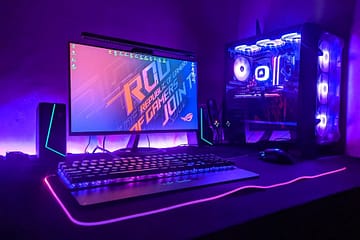Portable projector screens are a convenient and versatile way to enjoy high-quality video projection in a variety of settings. Whether you’re giving a presentation at work, hosting a movie night at home, or setting up a backyard movie screening, a portable projector screen can provide a professional and polished display for your content. These screens are designed to be lightweight and easy to transport, making them ideal for on-the-go use. They come in a range of sizes and styles to suit different needs, and can be set up quickly and easily in almost any location. In this article, we’ll explore the different types of portable projector screens available, discuss the factors to consider when choosing one, and provide tips for setting up and maintaining your screen for optimal performance.
Types of Portable Projector Screens
There are several different types of portable projector screens to choose from, each with its own unique features and benefits. One popular option is the tripod screen, which is supported by a stable tripod stand that can be easily adjusted to the desired height. These screens are typically made of durable materials like vinyl or fabric, and can be rolled up for compact storage and transport. Another common type of portable projector screen is the pull-up screen, which features a retractable design that allows the screen to be easily pulled up and locked into place when in use, and then retracted back into its housing for storage. These screens are often made of high-quality materials like fiberglass or aluminum, and are designed to be lightweight and easy to carry. In addition to these options, there are also inflatable projector screens, which can be quickly inflated and set up for outdoor use, and foldable screens that can be easily folded and unfolded for quick setup and takedown.
Factors to Consider When Choosing a Portable Projector Screen
When choosing a portable projector screen, there are several important factors to consider to ensure that you select the right screen for your needs. One of the most important considerations is the size of the screen, as this will determine the viewing area and the overall impact of your projection. Consider the size of the space where you’ll be using the screen, as well as the distance from which your audience will be viewing the content. You’ll also want to consider the aspect ratio of the screen, which refers to the proportional relationship between the width and height of the screen. Common aspect ratios include 4:3, which is ideal for standard presentations and video content, and 16:9, which is better suited for widescreen content like movies and HD video. Another important factor to consider is the material of the screen, as this will affect the quality of the projected image. Look for screens made of high-quality materials like PVC or fiberglass, which provide a smooth and wrinkle-free surface for optimal image clarity. Finally, consider the portability and ease of setup of the screen, as well as any additional features like adjustable height or built-in keystone correction for easy image alignment.
Setting Up Your Portable Projector Screen
Setting up a portable projector screen is a relatively simple process, but it’s important to follow a few key steps to ensure that you achieve the best possible image quality. The first step is to choose a suitable location for your screen, taking into account factors like ambient light, viewing distance, and any potential obstructions. Once you’ve selected a location, unfold or extend the screen according to its specific design, making sure that it is securely supported and level. If you’re using a tripod screen, adjust the height of the stand as needed to achieve the desired viewing angle. Next, position your projector at the appropriate distance from the screen, ensuring that it is centered and aligned with the screen’s surface. Use any built-in keystone correction features on your projector or screen to adjust the image as needed for optimal clarity and alignment. Finally, connect your video source to the projector and adjust the focus and zoom settings as needed to achieve a clear and sharp image on the screen.
Tips for Maximizing Your Portable Projector Screen Experience
To get the most out of your portable projector screen, there are several tips and tricks you can use to enhance your viewing experience. One important tip is to carefully manage ambient light in your viewing environment, as excessive light can wash out the projected image and reduce overall image quality. Consider using blackout curtains or shades to block out natural light, or positioning your screen in a location with minimal ambient light for optimal results. Additionally, consider using a high-quality projector with sufficient brightness and contrast capabilities to ensure that your image is clear and vibrant even in challenging lighting conditions. Another important tip is to regularly clean and maintain your screen to ensure that it remains in optimal condition for long-term use. Use a soft cloth or brush to gently remove any dust or debris from the screen’s surface, and avoid using harsh chemicals or abrasive materials that could damage the screen’s finish. Finally, consider investing in accessories like portable speaker systems or outdoor seating to enhance your overall viewing experience and create a more immersive environment for your audience.
Maintenance and Care for Your Portable Projector Screen
Proper maintenance and care are essential for ensuring that your portable projector screen remains in optimal condition for long-term use. One important aspect of maintenance is regular cleaning of the screen’s surface to remove dust, dirt, and other debris that can accumulate over time. Use a soft cloth or brush to gently wipe down the screen’s surface, taking care not to apply excessive pressure or use abrasive materials that could damage the screen’s finish. If necessary, use a mild detergent or cleaning solution to remove stubborn stains or marks from the screen, but be sure to thoroughly rinse and dry the screen afterwards to prevent any residue from affecting image quality. In addition to regular cleaning, it’s important to store your portable projector screen properly when not in use to prevent damage or wear. Roll up or retract the screen according to its specific design, taking care to avoid creasing or folding the material in a way that could cause permanent damage. Store the screen in a cool, dry location away from direct sunlight or extreme temperatures to prevent warping or discoloration.
Conclusion and Final Thoughts on Portable Projector Screens
In conclusion, portable projector screens are a versatile and convenient way to enjoy high-quality video projection in a variety of settings. With a range of sizes and styles available, these screens can be easily transported and set up for professional presentations, movie nights, outdoor screenings, and more. When choosing a portable projector screen, it’s important to consider factors like size, aspect ratio, material quality, and portability to ensure that you select the right screen for your needs. Setting up your portable projector screen is a relatively simple process that requires careful consideration of factors like location, ambient light, and image alignment for optimal results. By following tips for maximizing your viewing experience and properly maintaining your screen, you can ensure that it remains in optimal condition for long-term use. With proper care and attention, a portable projector screen can provide years of high-quality video projection for a wide range of applications.


